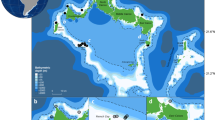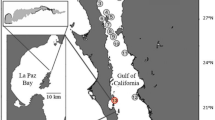Abstract
Changes in animal population size are driven by the interactions between intrinsic processes and extrinsic forces, and identifying the proximate mechanisms behind population change remains a fundamental question in ecology. Here we report on how measuring behavioural and state proxies of food availability among populations experiencing different growth rates can be used to rapidly identify proximate drivers of population trends. In recent decades, the Cape gannet Morus capensis has shown a major distributional shift with historically large colonies in Namibia decreasing rapidly, whilst numbers at South African colonies have increased, suggesting contrasting environmental conditions in the two regions. We compared per capita growth rates of five of the six extant colonies with foraging range (using miniaturised Global Positioning System loggers), foraging work rate, food delivery rates and body condition of breeding adults. We found significant associations between the rate of population change, individual behaviour, energetic gain and body condition that indicate that recent population changes are associated with extrinsic effects. This study shows that behavioural and state data can be used to identify important drivers of population change, and their cost-effectiveness ensures that they are an appealing option for measuring the health of animal populations in numerous situations.




Similar content being viewed by others
References
Ainley DG, Ford RG, Brown ED, Suryan RM, Irons DB (2003) Prey resources, competition, and geographic structure of kittiwake colonies in Prince William Sound. Ecology 84:709–723
Albon SD, Coulson TN, Brown D, Guinness FE, Pemberton JM, Clutton-Brock TH (2000) Temporal changes in key factors and key age groups influencing the population dynamics of female red deer. J Anim Ecol 69:1099–1110
Barbraud C, Weimerskirch H (2003) Climate and density shape population dynamics of a marine top predator.Proc R Soc Lond B Biol Sci 270:2111–2116
Batchelor AL, Ross GJB (1984) The diet and implications of dietary change of Cape gannets on Bird Island, Algoa Bay. Ostrich 55:45–63
Berryman AA (2004) Limiting factors and population regulation. Oikos 105:667–670
Birkhead TR, Furness RW (1985) Regulation of seabird populations. In: Sibly RM, Smith RH (eds) Behavioural ecology: ecological consequences of adaptive behaviour. Blackwell, Oxford, pp 145–167
Boulinier T, Danchin E (1997) The use of conspecific reproductive success for breeding patch selection in terrestrial migratory species. Evol Ecol 11:505–517
Boyer DC, Boyer HJ, Fossen I, Kreiner A (2001) Changes in abundance of the northern Benguela sardine stock during the decade 1990–2000, with comments on the relative importance of fishing and the environment. S Afr J Mar Sci 23:67–84
Cadiou B, Monnat JY (1996) Parental attendance and squatting in the kittiwake Rissa tridactyla during the rearing period. Bird Stud 43:164–171
Chastel O, Weimerskirch H, Jouventin P (1995) Influence of body condition on reproductive decision and reproductive success in the Blue Petrel. Auk 112:964–972
Clutton-Brock TH, Coulson T (2002) Comparative ungulate dynamics: the devil is in the detail. Philos Transact R Soc Lond B Biol Sci 357:1285–1298
Cook JG, Johnson BK, Cook RC, Riggs RA, Delcurto T, Bryant LD, Irwin LL (2004) Effects of summer-autumn nutrition and parturition date on reproduction and survival of elk.Wildl Monogr 155:1–61
Coulson T, Catchpole EA, Albon SD, Morgan BJT, Pemberton JM, Clutton-Brock TH, Crawley MJ, Grenfell BT (2001) Age, sex, density, winter weather, and population crashes in Soay sheep. Science 292:1528–1531
Crawford RJM (1999) Seabird responses to long-term changes of prey resources off southern Africa. In: Adams N, Slotow R (eds) In: Proceedings of 22nd international ornithology congress of birdlife South Africa, Johannesburg, Durban
Croxall JP, Prince PA (1996) Potential interactions between wandering albatrosses and long-line fisheries for Dissostichus at South Georgia. CCAMLR Science 3:101–110
Danchin E, Wagner RH (1997) The evolution of coloniality: the emergence of new perspectives. Trends Ecol Evol 12:342–347
Dittmann T, Zinsmeister D, Becker PH (2005) Dispersal decisions: common terns, Sterna hirundo, choose between colonies during prospecting. Anim Behav 70:13–20
du Toit M, Bartlett PA (2001) ‘Soaked’ Cape gannets at Ichaboe Island, Namibia. Bird Numbers 10:8
Frederiksen M, Harris MP, Wanless S (2005) Inter-population variation in demographic parameters: a neglected subject? Oikos 111:209–214
Godfray HCJ, Rees M (2002) Population growth rates: issues and an application. Philos Transact R Soc Lond B Biol Sci 357:1307–1319
Grémillet D, Dell’Omo G, Ryan PG, Peters G, Ropert-Coudert Y, Weeks SJ (2004) Offshore diplomacy, or how seabirds mitigate intra-specific competition: a case study based on GPS tracking of Cape gannets from neighbouring colonies. Mar Ecol Prog Ser 268:265–279
Griffin LR, Thomas CJ (2000) The spatial distribution and size of rook Corvus frugilegus breeding colonies is affected by both the distribution of foraging habitat and by intercolony competition. Proc R Soc Lond B Biol Sci 267:1463–1467
Griffiths CL, Van Sittert L, Best PB, Brown AC, Clark BM, Cook PA, Crawford RJM, David JHM, Davies BR, H GM, Hutchings K, Jerardino A, Kruger N, Lamberth S, Leslie RW, Melville-Smith R, Tarr RJQ, Van der Lingen CD (2004) Impacts of human activities on marine animal life in the Benguela: a historical overview. In: Gibson R, Atkinson R, Gordon J (eds) Oceanography and marine biology: an annual review, vol 42, pp 303–392
Hamer KC, Monaghan P, Uttley JD, Walton P, Burns MD (1993) The influence of food supply on the breeding ecology of kittiwakes Rissa tridactyla in Shetland. Ibis 135:255–263
Hochscheid S, Grémillet D, Wanless S, du Plessis MA (2002) Black and white under the South African sun: are juvenile Cape gannets heat stressed? J Therm Biol 27:325–332
Inchausti P, Guinet C, Koudil M, Durbec JP, Barbraud C, Weimerskirch H, Cherel Y, Jouventin P (2003) Inter-annual variability in the breeding performance of seabirds in relation to oceanographic anomalies that affect the Crozet and the Kerguelen sectors of the Southern Ocean. J Avian Biol 34:170–176
Jenouvrier S, Barbraud C, Weimerskirch H (2003) Effects of climate variability on the temporal population dynamics of southern fulmars. J Anim Ecol 72:576–587
Kenward RE, Clarke RT, Hodder KH, Walls SS (2001) Density and linkage estimators of home range: nearest-neighbor clustering defines multinuclear cores. Ecology 82:1905–1920
Krebs CJ (2002) Two complementary paradigms for analysing population dynamics. Philos Transact R Soc Lond B Biol Sci 357:1211–1219
Lewis S, Sherratt TN, Hamer KC, Wanless S (2001) Evidence of intra-specific competition for food in a pelagic seabird. Nature 412:816–819
Lewis S, Hamer KC, Money L, Griffiths R, Wanless S, Sherratt TN (2004) Brood neglect and contingent foraging behavior in a pelagic seabird. Behav Ecol Sociobiol 56:81–88
McGlynn TP, Hoover JR, Jasper GS, Kelly MS, Polis AM, Spangler CM, Watson BJ (2002) Resource heterogeneity affects demography of the Costa Rican ant Aphaenogaster araneoides. J Trop Ecol 18:231–244
Milner JM, Elston DA, Albon SD (1999) Estimating the contributions of population density and climatic fluctuations to interannual variation in survival of Soay sheep. J Anim Ecol 68:1235–1247
Moss R, Watson A, Parr R (1996) Experimental prevention of a population cycle in red grouse. Ecology 77:1512–1530
Murphy EC, Springer AM, Roseneau DG (1991) High annual variability in reproductive success of kittiwakes (Rissa tridactyla l.) at a Colony in Western Alaska. J Anim Ecol 60:515–534
Newton I (1998) Population limitation in birds. Academic, London
Patterson HD, Thompson R (1971) Recovery of inter-block information when block sizes are unequal. Biometrika 58:545–554
Rand RW (1963) The biology of guano producing seabirds—composition of colonies on the south–west African Islands. S Afr Fish Invest 46:1–26
Reid JM, Bignal EM, Bignal S, McCracken DI, Monaghan P (2003) Environmental variability, life-history covariation and cohort effects in the red-billed chough Pyrrhocorax pyrrhocorax. J Anim Ecol 72:36–46
Ridley J, Komdeur J, Sutherland WJ (2003) Population regulation in group-living birds: predictive models of the Seychelles warbler. J Anim Ecol 72:588–598
Ropert-Coudert Y, Grémillet D, Kato A, Ryan PG, Naito Y, Le Maho Y (2004) A fine-scale time budget of Cape gannets provides insights into the foraging strategies of coastal seabirds. Anim Behav 67:985–992
Roux JP (2003) Risks. In: Molloy F, Reinikainen T (eds) Namibia’s marine environment, vol Vii. Directorate of environmental affairs, MET, Windhoek, Namibia, pp 149–164
Roux JP, Shannon LJ (2004) Ecosystem approach to fisheries management in the northern Benguela: the Namibian experience. Afr J Mar Sci 26:79–93
Saether BE, Engen S, Matthysen E (2002) Demographic characteristics and population dynamical patterns of solitary birds. Science 295:2070–2073
Shannon LV, Crawford RJM, Pollock DE, Hutchings L, Boyd AJ, Tauntonclark J, Badenhorst A, Melvillesmith R, Augustyn CJ, Cochrane KL, Hampton I, Nelson G, Japp DW, Tarr RJQ (1992) The 1980s - a Decade of Change in the Benguela Ecosystem. S Afr J Mar Sci 12:271–296
Sibly RM, Hone J (2002) Population growth rate and its determinants: an overview. Philos Transact R Soc Lond B Biol Sci 357:1153–1170
Sibly RM, Hone J, Clutton-Brock TH (2002) Population growth rate: determining factors and role in population regulation - introduction. Philos Transact R Soc Lond B Biol Sci 357:1149–1151
Sibly RM, Barker D, Denham M, Hone J, Pagel P (2005) On the regulation of populations of mammals, birds, fish and insects. Science 309:607–610
Sinclair ARE (1989) Population regulation in animals. In: Cherrett JM (eds) Ecological concepts: the contribution of ecology to an understanding of the natural world. Blackwell, Oxford
Turchin P (1999) Population regulation: a synthetic view. Oikos 84:153–159
Weimerskirch H, Brothers N, Jouventin P (1997) Population dynamics of wandering albatross Diomedea exulans and Amsterdam albatross D. amsterdamensis in the Indian Ocean and their relationships with long-line fisheries: conservation implications. Biol Conserv 79:257–270
Wendeln H, Becker PH (1999) Effects of parental quality and effort on the reproduction of common terns. J Anim Ecol 68:205–214
Williams BK, Nichols JD, Conroy MJ (2001) Analysis and management of animal populations. Academic, San Diego
Wilson RP, Scolaro JA, Gremillet D, Kierspel MAM, Laurenti S, Upton J, Gallelli H, Quintana F, Frere E, Muller G, Straten MT, Zimmer I (2005) How do Magellanic Penguins cope with variability in their access to prey? Ecol Monogr 75:379–401
Acknowledgements
This study was funded by grants from the Association for the Study of Animal Behaviour, the British Council, the UK Embassy Paris, Centre National de la Recherche Scientifique, the South African National Research Foundation and the University of Cape Town. The authors sincerely thank P. Bartlett, Y. Ropert-Coudert, B. Dundee, M. P. Harris, J. James, R. Jones, N. Uhongora and S. Wepener for their help with fieldwork and logistics. Thanks also to G. Peters and G. Dell’Omo for support with the loggers and to S. Albon, P. Becker, M. Frederiksen, S. Hatch, M. Marquiss, F. Mougeot, K. Peard, J-P. Roux, T. Sherratt and an anonymous referee for commenting on various drafts of this paper, and for very helpful discussions. The South African National Parks, Cape Nature Conservation and the Namibian Ministry of Fisheries & Marine Resources granted access to the islands and provided permission to attach loggers to the gannets.
Author information
Authors and Affiliations
Corresponding author
Additional information
Communicated by Roland Brandl
Rights and permissions
About this article
Cite this article
Lewis, S., Grémillet, D., Daunt, F. et al. Using behavioural and state variables to identify proximate causes of population change in a seabird. Oecologia 147, 606–614 (2006). https://doi.org/10.1007/s00442-005-0321-z
Received:
Accepted:
Published:
Issue Date:
DOI: https://doi.org/10.1007/s00442-005-0321-z




